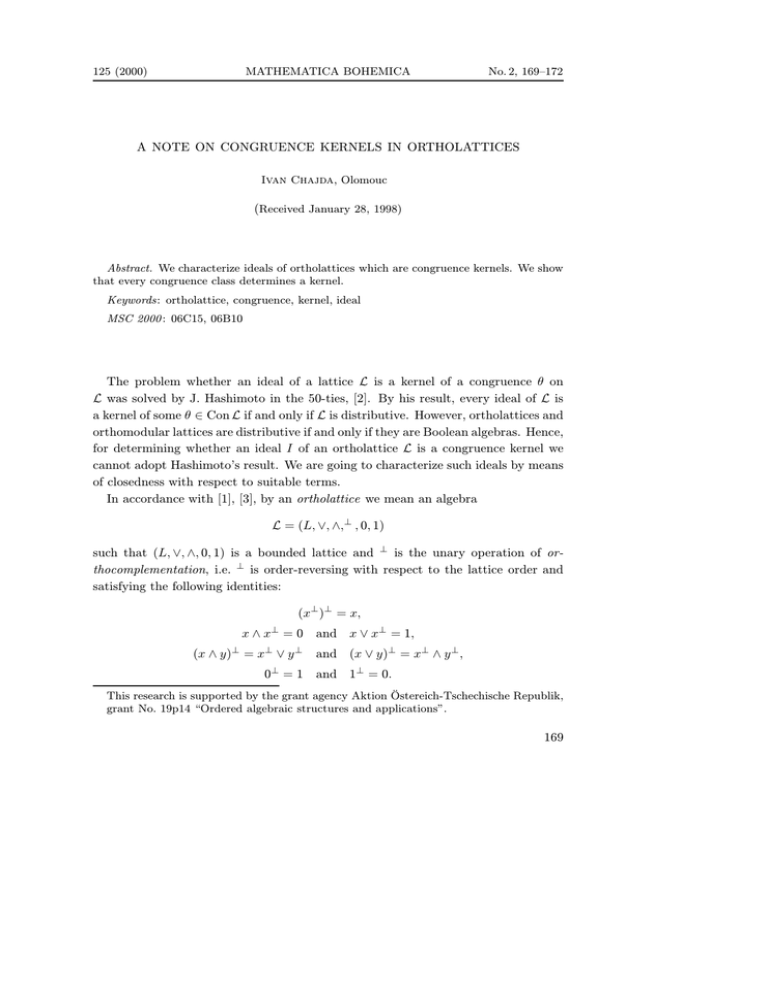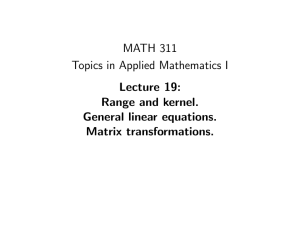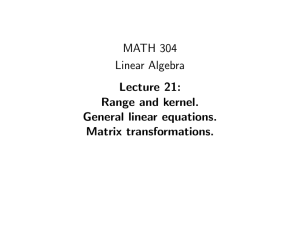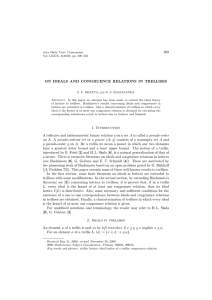A NOTE ON CONGRUENCE KERNELS IN ORTHOLATTICES (
advertisement

125 (2000)
MATHEMATICA BOHEMICA
No. 2, 169–172
A NOTE ON CONGRUENCE KERNELS IN ORTHOLATTICES
Ivan Chajda, Olomouc
(Received January 28, 1998)
Abstract. We characterize ideals of ortholattices which are congruence kernels. We show
that every congruence class determines a kernel.
Keywords: ortholattice, congruence, kernel, ideal
MSC 2000 : 06C15, 06B10
The problem whether an ideal of a lattice L is a kernel of a congruence θ on
L was solved by J. Hashimoto in the 50-ties, [2]. By his result, every ideal of L is
a kernel of some θ ∈ Con L if and only if L is distributive. However, ortholattices and
orthomodular lattices are distributive if and only if they are Boolean algebras. Hence,
for determining whether an ideal I of an ortholattice L is a congruence kernel we
cannot adopt Hashimoto’s result. We are going to characterize such ideals by means
of closedness with respect to suitable terms.
In accordance with [1], [3], by an ortholattice we mean an algebra
L = (L, ∨, ∧,⊥ , 0, 1)
such that (L, ∨, ∧, 0, 1) is a bounded lattice and ⊥ is the unary operation of orthocomplementation, i.e. ⊥ is order-reversing with respect to the lattice order and
satisfying the following identities:
(x⊥ )⊥ = x,
x ∧ x⊥ = 0
(x ∧ y)⊥ = x⊥ ∨ y ⊥
0⊥ = 1
and x ∨ x⊥ = 1,
and (x ∨ y)⊥ = x⊥ ∧ y ⊥ ,
and 1⊥ = 0.
This research is supported by the grant agency Aktion Östereich-Tschechische Republik,
grant No. 19p14 “Ordered algebraic structures and applications”.
169
Roughly speaking, ortholattices satisfy all axioms of Boolean algebras except distributivity.
By an ideal I of an ortholattice L we mean the lattice ideal of (L, ∨, ∧), i.e. ∅ =
I ⊆ L with
a, b ∈ I ⇒ a ∨ b ∈ I
a ∈ I, x ∈ L ⇒ a ∧ x ∈ I.
An example of an ortholattice which is neither distributive nor modular is shown
in Fig. 1:
1
y
x⊥
y⊥
x
0
Fig. 1.
Let θ be a congruence on an ortholattice L. By a kernel of θ we mean the set
Ker θ = {a ∈ L ; a, 0 ∈ θ}.
.
(1) An ideal of an ortholattice L need not be a kernel of any congruence on L. For example, I(x) = {x, 0} is an ideal of the ortholattice in Fig. 1 but
it is not a kernel of any θ ∈ Con L; if x, 0 ∈ θ for θ ∈ Con L then also y, 0 ∈ θ
but y ∈
/ I(x).
(2) If an ideal I of an ortholattice L is a kernel of some θ ∈ Con L then θ need
not be unique. For example, {0} is an ideal of L in Fig. 1 but it is the kernel of
the identity congruence on L as well as of the congruence given by the partition
{0}, {x, y}, {x⊥ , y ⊥ }, {1}.
For characterizing the ideals which are congruence kernels in ortholattices we recall
the well-known result of A. I. Mal’cev [4]:
Proposition. Let A = (A, F ) be an algebra, ∅ = B ⊆ A. B is a class of some
congruence on A if and only if for every c, d ∈ B and each unary polynomial τ (x)
over A, τ (c) ∈ B ⇒ τ (d) ∈ B.
170
Recall that by a unary polynomial τ (x) over A = (A, F ) we mean a unary function
τ : A → A such that there exists an (n + 1)-ary term function t(y, x1 , . . . , xn ) of type
F and elements a1 , . . . , an ∈ A such that τ (x) = t(x, a1 , . . . , an ).
We are ready to formulate our first result:
Theorem 1. An ideal I of an ortholattice L is a kernel of some θ ∈ Con L if and
only if for each (n + 1)-ary term t, for every a1 , . . . , an ∈ L and every i1 , i2 , i3 ∈ I
⊥
we have (i⊥
1 ∧ t(i2 , a1 , . . . , an )) ∧ t(i3 , a1 , . . . , an ) ∈ I.
.
Let I be a kernel of some θ ∈ Con L, let t be an (n + 1)-ary term of
L and a1 , . . . , an ∈ L, i1 , i2 , i3 ∈ I. Since 0 ∈ I we have i1 , 0 ∈ θ, i2 , 0 ∈ θ,
i3 , 0 ∈ θ. Moreover,
(0⊥ ∧ t(0, a1 , . . . , an ))⊥ ∧ t(0, a1 , . . . , an ) = 0,
whence, by the substitution property of θ, also
⊥
(i⊥
1 ∧ t(i2 , a1 , . . . , an )) ∧ t(i3 , a1 , . . . , an ), 0 =
⊥
(i⊥
1 ∧ t(i2 , a1 , . . . , an )) ∧ t(i3 , a1 , . . . , an ),
(0⊥ ∧ t(0, a1 , . . . , an ))⊥ ∧ t(0, a2 , . . . , an ) ∈ θ
⊥
i.e. (i⊥
1 ∧ t(i2 , a1 , , . . . , an )) ∧ t(i3 , a1 , . . . , an ) ∈ Ker θ = I.
Conversely, let I be an ideal of an ortholattice L which satisfies the condition of
Theorem 1. Suppose i, j ∈ I and τ (i) ∈ I for a unary polynomial τ (x) over L. Hence,
τ (x) = t(x, a1 , . . . , an ) for some (n + 1)-ary term t and some elements a1 , . . . , an ∈ L.
Applying our condition for i1 = τ (i), i2 = i, i3 = j, we obtain
τ (j) = (τ (i)⊥ ∧ τ (i))⊥ ∧ τ (j) ∈ I.
By the Proposition, we are done since I is a 0-class of some θ ∈ Con L , i.e. I = Ker θ.
Theorem 2. Let L be an ortholattice. Then for each θ ∈ Con L, the kernel Ker θ
is determined by every class of θ.
. Let θ ∈ Con L and let C be an arbitrary class of θ. Define a subset I
of L as follows:
(∗) a ∈ I iff there exists c ∈ C such that a ∧ c = 0 and a ∨ c ∈ C. We prove that
I = Ker θ.
(i) 0 ∈ I since c ∧ 0 = 0 and c ∨ 0 = c ∈ C for each c ∈ C.
171
(ii) Let a ∈ I. Denote d = a ∨ c. Then c, d ∈ C imply c, d ∈ θ and d ∧ a =
(a ∨ c) ∧ a = a whence a, 0 = d ∧ a, c ∧ a ∈ θ, i.e. a ∈ Ker θ.
(iii) Suppose a ∈ Ker θ. Then a, 0 ∈ θ, thus also a⊥ , 1 = a⊥ , 0⊥ ∈ θ. Hence,
for each c0 ∈ C we have c0 , a⊥ ∧ c0 = 1 ∧ c0 , a⊥ ∧ c0 ∈ θ, i.e. also a⊥ ∧ c0 ∈ C.
Further,
a⊥ ∧ c0 , (a⊥ ∧ c0 ) ∨ a = (a⊥ ∧ c0 ) ∨ 0, (a⊥ ∧ c0 ) ∨ a ∈ θ,
i.e. also (a⊥ ∧c0 )∨a ∈ C. We can set c = a⊥ ∧c0 . Then c ∈ C, c∧a = a⊥ ∧c0 ∧a = 0
and c ∨ a = (a⊥ ∧ c0 ) ∨ a ∈ C. By (∗) we have a ∈ I. Together, I = Ker θ, which
proves the assertion.
References
[1] Beran L.: Orthomodular lattices. Algebraic Approach. Academia, Praha, 1984.
[2] Hashimoto J.: Ideal theory for lattices. Math. Japon. 2 (1952), 149–186.
[3] Kalmbach B.: Orthomodular Lattices. London Math. Soc. Monographs 18, Academic
Press, London, 1983.
[4] Mal’cev A. I.: On the general theory of algebraic systems. Mat. Sb. 35(77) (1954), 3–20.
(In Russian.)
Author’s address: Ivan Chajda, Department of Algebra and Geometry, Palacký University Olomouc, Tomkova 40, 779 00 Olomouc, Czech Republic, e-mail: chajda@risc.upol.cz.
172








